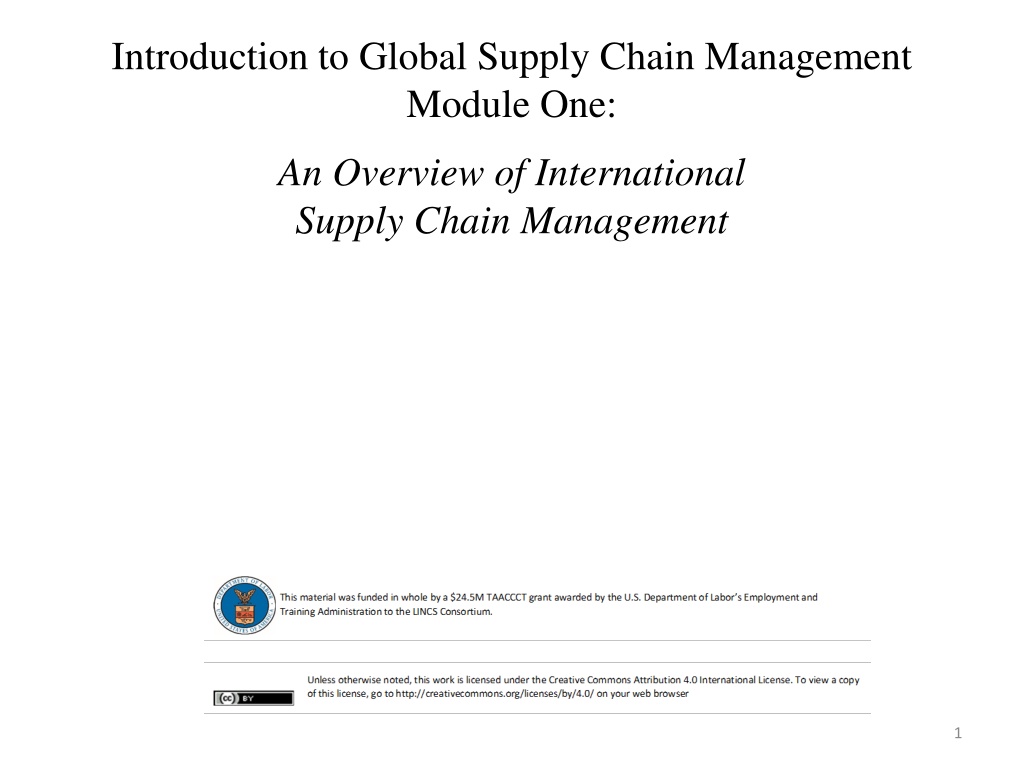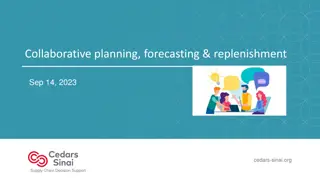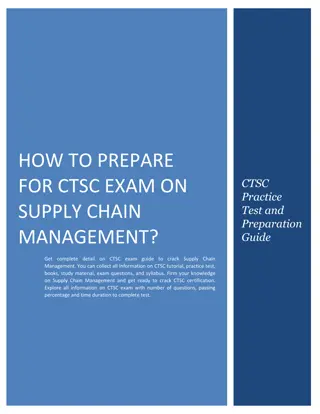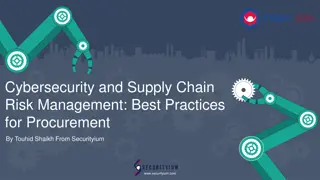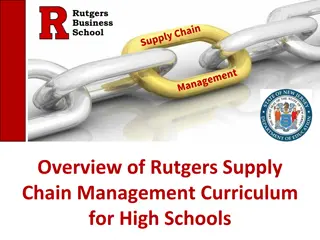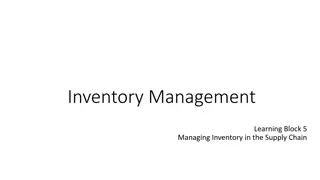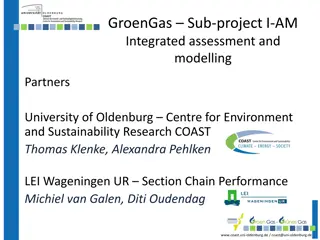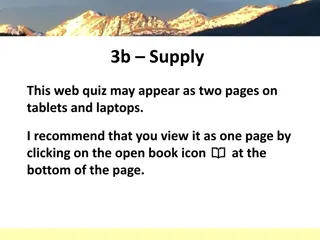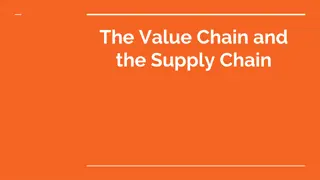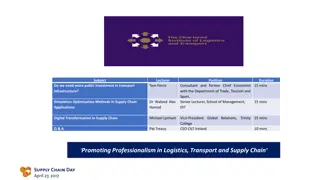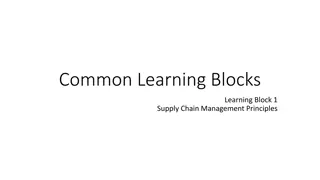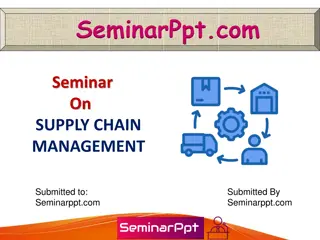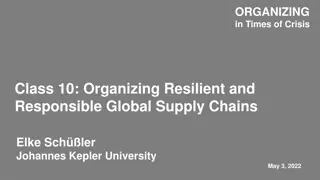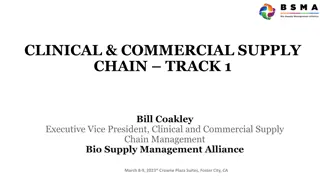Exploring Global Supply Chain Management Dynamics
Delve into the intricacies of global supply chain management, encompassing the coordination of sourcing, procurement, logistics, and collaboration with various partners in a cohesive manner. Understand the essential players, functional areas, and processes that drive the efficiency of international supply chains.
Download Presentation

Please find below an Image/Link to download the presentation.
The content on the website is provided AS IS for your information and personal use only. It may not be sold, licensed, or shared on other websites without obtaining consent from the author. Download presentation by click this link. If you encounter any issues during the download, it is possible that the publisher has removed the file from their server.
E N D
Presentation Transcript
Introduction to Global Supply Chain Management Module One: An Overview of International Supply Chain Management 1
Class Agenda Supply Chain Management & Logistics defined Functional activities within a global supply chain (Who does what?) An introduction to process design The role of logistics management in import/export trade 2
Supply Chain Management "Supply Chain Management encompasses the planning and management of all activities involved in sourcing and procurement, conversion, and all logistics management activities. Importantly, it also includes coordination and collaboration with channel partners, which can be suppliers, intermediaries, third-party service providers, and customers. In essence, supply chain management integrates supply and demand management within and across companies. Supply Chain Management is an integrating function with primary responsibility for linking major business functions and business processes within and across companies into a cohesive and high-performing business model. It includes all of the logistics management activities noted above, as well as manufacturing operations, and it drives coordination of processes and activities with and across marketing, sales, product design, finance and information technology." -Council of Supply Chain Management Professionals 3
A Basic Global Supply Chain Supplier Origin Trucker Origin Forwarder International Transportation Origin: Somewhere Overseas CHB U.S. transport W&D Order Fulfillment Last Mile Client Destination: Somewhere in the U.S.A. 4
Global Supply Chain Management: Who are the players? Buyers & Sellers Manufacturers Tier I, II & III suppliers Banks Insurance firms Freight forwarders Customs entities Customs brokers Other Government Agencies (OGA s) 5
Global Supply Chain Management: Who are the players? Truckers Airlines Steamship lines Rail companies Warehouse companies National mail systems Small parcel (UPS & FedEx) Fulfillment houses Test & Repair shops 6
Global Supply Chain Management: Different Functional Areas & Processes Finance Research & Development Product design Forecasting Sourcing Materials Requirements Planning Purchasing Sales & Marketing 7
Global Supply Chain Management: Different Functional Areas & Processes Production Planning Inbound/Outbound logistics Information Technology Customer service Risk Management & Legal Human Resources Accounting 8
Supply Chain Management (The short, tactical version) A time-phased approach to forecasting and meeting the demand for raw materials, work in process and/or finished goods The four cornerstones of supply chain management are: Product sales Landed cost Lead time rationalization Inventory management Technology & cloud-based visibility across the entire supply chain are key to success 9
Supply Chain Management: Key Definitions Landed Costs: The unit price for a product plus all other costs associated with shipping the product from origin to destination Example: The purchase of women s handbags from a factory in Vietnam Price per handbag (unit cost) Trucking from the factory to the freight forwarder s warehouse Air or ocean transportation plus all documentation costs Customs clearance in the U.S. Customs duties U.S. warehousing & trucking to final destination 10
Supply Chain Management: Key Definitions Cumulative Lead Times: The time that transpires between the moment a need is recognized and when that need is fulfilled Example: The purchase of women s handbags from a factory in Vietnam Send purchase order to the vendor Vendor s production time International shipping Customs clearance U.S. domestic distribution Local delivery 11
Supply Chain Management: Key Definitions Inventory Management: All activities associated with the valuation, acquisition, shipment, location, storage, sale, distribution, disposition, recovery and disposal of merchandise related to the operation of a firm s business Goal is to meet the customer service requirements of the company Product availability 12
Different Industries & Business Models Determine How Supply Chains Are Designed Retailer (brick & mortar) E-Commerce Wholesaler/Distributor Manufacturer (OEM) Tier I, II or III supplier Agricultural importer/exporter Marketer/Merchandiser 13
Different Types of Inventory & Operating Models Also Influence How Supply Chains Are Designed Types of Inventory Operating Model Build to stock Build to order Assemble to Order Engineer to Order Just In Time Vendor Managed Inventories Raw materials Components/sub-assemblies Work In Process Finished goods Distribution inventory Accessories Spare parts MRO 14
The Role of Logistics In Global Supply Chain Management 15
Logistics Management "Logistics management is that part of supply chain management that plans, implements, and controls the efficient, effective forward and reverse flow and storage of goods, services, and related information between the point of origin and the point of consumption in order to meet customers' requirements. Logistics management activities typically include inbound and outbound transportation management, fleet management, warehousing, materials handling, order fulfillment, logistics network design, inventory management, supply/demand planning, and management of third party logistics services providers. To varying degrees, the logistics function also includes sourcing and procurement, production planning and scheduling, packaging and assembly, and customer service. It is involved in all levels of planning and execution-strategic, operational, and tactical. Logistics management is an integrating function which coordinates and optimizes all logistics activities, as well as integrates logistics activities with other functions, including marketing, sales, manufacturing, finance, and information technology." -Council of Supply Chain Management Professionals 16
Logistics Activities & Services Local domestic trucking Long haul domestic trucking Drayage Domestic air freight Rail service International air/ocean freight Documentation service Multi-modal services Customs clearance Domestic W&D Inventory management 17
Logistics Activities & Services JIT/Line side feeding Kitting & Packaging Order Management Fulfillment/Reverse, T&R Cold chain Bonded warehousing Foreign Trade Zone Vendor management 18
Global Logistics Management: Who are the players? Truckers Freight forwarders Customs brokers Airlines Steamship lines Rail companies Public warehousemen 19
Global Logistics Management: Who are the players? Bonded warehousemen Foreign Trade Zone Operators National mail systems Integrators (UPS & FedEx) Fulfillment houses Test & Repair shops Consulting companies 20
Supply Chain Management & Logistics: Process Design & Execution Supplier Origin Trucker Origin Forwarder International Transportation Origin: Somewhere Overseas CHB U.S. transport W&D Order Fulfillment Last Mile Client Destination: Somewhere in the U.S.A. 21
Supply Chain & Logistics Processes A business process is a structured, measurable set of activities and tasks designed to produce a specified output for a particular customer or market. The sum of several inputs (products, manpower, physical plant, technology, etc.), processes are designed to satisfy the needs of both internal and external clients. The result of a process has two characteristics; the primary output and service requirements. Primary output is the direct result of the process inputs (a finished product or service), while the service requirements are the value added elements that surround the primary output (communications, follow up, technical support, correct billing, customer service, etc.) The combination of the primary output and service requirements are what we refer to as The Customer Experience. 22
Business Process Characteristics Should be a reflection of The Voice of The Client Must create value An activity that people are willing to pay for Are measurable, with a beginning and end Are intended to be reproduced consistently Not linear, but circular 23
Business Process Characteristics Typically involve several internal & external deparments and/or entities They are never perfect and can continuously be improved Are based on cause & effect relationships In a business environment, one person s output automatically becomes another person s input 24
Processes: Cause & Effect x = inputs, y= outputs Y = f(x) The Customer Experience Manpower (x) Methodology (x) Output (y) Process Products (x) Physical Plant (x) Environment (x) 25
Logistics Process Design: Introduction to Flowcharts Start Process Step Process step No Decision Pt Yes Process Step End 26
The Importance of Flowcharts To Process Design The first principle of Total Quality Management (TQM) is, A process cannot be improved upon until the existing process is mapped out A flowchart provides a visual overview of a process Defines steps in a process along with ownership (for execution) Helps to expose inter-dependencies between people, departments and functions (resonance) A communications & planning tool Facilitates troubleshooting 27
Fundamentals of Flowchart Design A flowchart is a graphic representation of the tasks, decisions and activities that take place during the execution of a process Flowcharts are drawn from the top of a page to the bottom, and from left to right The definition of the process should be clearly articulated on the flowchart The beginning and end of the process should be clearly noted 28
Fundamentals of Flowchart Design Individual steps in the process should be described using one-verb phrases (place purchase order, begin production, etc) Each step in the process must be kept in its proper sequence The scope of the process must be carefully observed Use standard flowcharting symbols (American National Standards Institute, Inc) 29
Basic Flowchart Symbols The symbol that depicts the beginning or end of a process is an oval An arrowhead with a line is used to show the direction of flow in a process A tapered rectangle represents the use of a document in a process The symbol used to demonstrate a process operation is a rectangle Multiple tapered rectangles represents the presence of more than one document in a process step The diamond is used to denote a decision point in the process 30
Sample Flowchart-Getting Ready For Work: Target time of 30 minutes No Prepare clothes Clothes Ready? Begin Yes Alarm clock sounds at 6:00 a..m Get dressed No Hit snooze button 10 minutes Get up? Eat breakfast Yes Leave for work Take shower End 31
End of Module One Congratulations!!! 32
